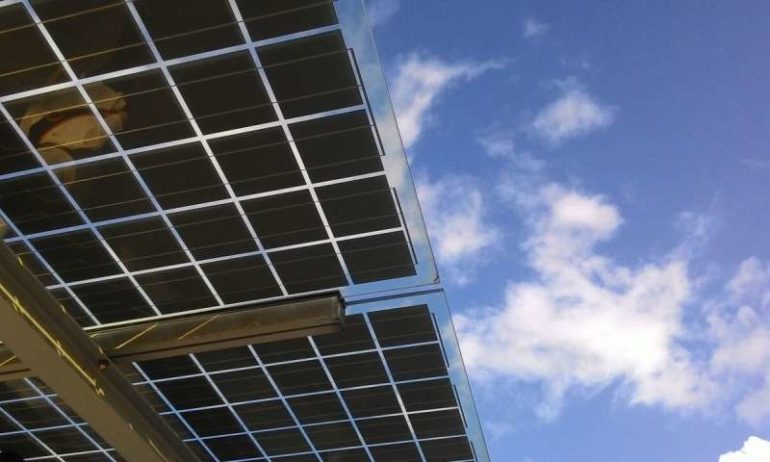December 11, 2020
feature
In recent years, researchers worldwide have been trying to develop solar cells and other technologies that can produce electrical energy from renewable sources, as these could reduce the emission of greenhouse gases and thus help to preserve life on our planet. Solar cells can be built using a variety of materials, including silicon, copper or other semiconductors.
Another class of materials that has proved to be highly promising for the fabrication of solar cells are perovskites, calcium titanium oxide minerals that can be extracted from the Earth’s mantle in specific geographical regions. This includes 2-D Ruddlesden-Popper (RP) perovskites, which have a unique structure that could enhance a device’s environmental stability and optoelectronic properties, without significantly compromising its efficiency.
Generally, 2-D RP perovskites have multiple quantum wells (QWs) with a random well width distribution, which can impair the thermodynamic stability of perovskite solutions. QWs are thin layers that confine particles in the dimension perpendicular to the surface of a given layer in a device (e.g., in a well-like space) , without restricting movement in other dimensions.
Researchers at Nanjing Tech University and other institutes in China have recently created solar cells using 2-D RP layered perovskites with phase-pure QWs and a single-well width. These solar cells, presented in a paper published in Nature Energy, can achieve remarkable power conversion efficiencies that are largely retained over time.
“We report phase-pure QWs with a single well width by introducing molten salt spacer n-butylamine acetate, instead of the traditional halide spacer n-butylamine iodide,” the researchers wrote in their paper. “Due to the strong ionic coordination between n-butylamine acetate and the perovskite framework, a gel of a uniformly distributed intermediate phase can be formed.”
The primary difference between the solar cells designed by this team of researchers and other similar ones developed in the past is the introduction of a layer of molten salt spacer n-butylamine acetate, which substitutes halide spacers n-butylamine iodide commonly used to fabricate solar cells based on 2-D RP-perovskites. The strong ionic coordination between this newly introduced layer and perovskites ultimately enables the formation of a gel made of compounds with a uniformly distributed intermediate phase.
This unique design produces phase-pure quantum well films with microscale grains that are vertically aligned. These gains are crystallized at their respective intermediate phases, which could ultimately increase the solar cells’ stability.
In a series of initial tests, the researchers found that the solar cells they created achieved a power conversion efficiency of 16.25% and a high open voltage of 1.31V. Moreover, they evaluated the solar cells in three different scenarios: after they were kept in an environment with 65 ± 10% humidity for 4,680 hours; after operating at 85 °C for 558 hours; and when they were placed under continuous light illumination for 1,100 hours. In all these three cases, the cells’ efficiency decreased by less than 10%.
These results suggest that the limitations associated with the QWs of previously developed RP perovskite-based solar cells could be overcome by introducing a molten salt spacer layer. In the future, the unique solar cell design presented in this recent paper could enable the creation of solar panels or other solar-powered devices that are both efficient and stable.
“Compared to the traditional all-inorganic QWs deposited with vacuum methods, the hybrid organic-inorganic metal-halide perovskite phase-pure QWs offer several improvements, including solution processability, low-temperature fabrication and atomic layer accuracy,” the researchers explained in their paper. “Considering the good stability, unique structure and optoelectronic properties, we anticipate that the phase-pure QWs will facilitate the development of solar cells and other perovskite-based optoelectronic devices, such as detectors, light-emitting diodes and lasers.”
Chemistry professor uses old materials to make newer, better solar cells
More information:
Chao Liang et al. Two-dimensional Ruddlesden–Popper layered perovskite solar cells based on phase-pure thin films, Nature Energy (2020). DOI: 10.1038/s41560-020-00721-5
2020 Science X Network
Citation:
New 2-D Ruddlesden-Popper (RP) layered perovskite-based solar cells (2020, December 11)
retrieved 11 December 2020
from https://techxplore.com/news/2020-12-d-ruddlesden-popper-rp-layered-perovskite-based.html
This document is subject to copyright. Apart from any fair dealing for the purpose of private study or research, no
part may be reproduced without the written permission. The content is provided for information purposes only.



